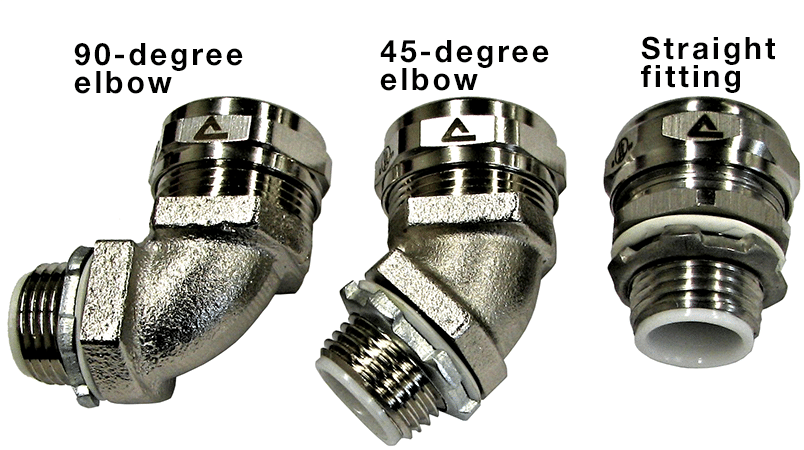Why Use Flexible Conduit Fittings?
What Are Flexible Conduit Fittings?
Flexible conduit fittings connect conduit to fixtures, machines or junction boxes, providing routing options while protecting wiring. Fittings must meet (Trade) size standards and have quality screw threads, allowing secure connections in confined spaces.
Fittings offer a reliable transition between conduit sections, junction boxes or electrical devices. Fittings ensure safe, insulated termination of energized wiring, while providing strain relief and protection.
When corrosion resistant materials are selected, fittings ease inspection, maintenance, upgrade or repair of electrical wiring. Here are fitting features (in some cases, required by the UL 514B Standard):
- Smooth bores enable easy wire pulling
- Insulated throats prevent strain and abrasion on wiring
- Water- and dust-tight seals conform to conduit jackets
- Ferrules cover conduit edges and prevent wire abrasion
- Lock nuts hold fittings securely to termination surfaces
- Threaded parts easily mate and can be tightened for a water-tight seal
See the blog A guide to conduit fitting parts for more information about ANACONDA SEALTITE® fitting parts.
Benefits of Using Flexible Conduit Fittings
A flexible electrical conduit fitting gives you versatility not available with rigid conduit options. Here are some key benefits of using flexible conduit fittings:
- Flexibility: Conduit fittings are made of threaded parts that can be assembled and disassembled as needed. By contrast, rigid conduit systems rely on glue or sealant that must be broken to make changes. ANACONDA SEALTITE® fittings are available in compact sizes, allowing easy installation in confined spaces. Straight, 45-degree and 90-degree fittings are available in various materials.
- Straight fittings allow wiring to go directly into its termination.
- A 45-degree fitting gives strain relief, allowing wiring to take a slight turn into its termination.
- A 90-degree fitting allows conduit to lie alongside a terminating fixture, providing strain relief for the wiring.
Fitting materials are corrosion resistant, making them ideal for outdoor applications where wiring needs to be protected from exposure.
- Install Easily: No special tools are required to install flexible conduit fittings, making the process quick and easy. SEALTITE® fittings are available in the standard Trade sizes, fitting conduit sizes and knockout holes in junction boxes.
- Durability: Flexible conduit fittings are designed to withstand harsh environmental conditions such as extreme temperatures, UV exposure, moisture and corrosive chemicals. This makes them ideal for outdoor use, where they can protect electrical wiring from extreme temperatures, inclement weather and water spray.
- Remove Easily: You may need to add or remove wires in your electrical system. With threaded flexible conduit fittings, the termination can be opened to remove or add wires to the conduit. Please note that international safety standards require threaded fittings to be tightened to standard torque values to prevent loosening or liquid intrusion. Please note, international safety standards require threaded fittings to be tightened to prevent loosening or liquid intrusion.
Flexible Conduit Fittings Have Various Applications
Flexible electrical conduit systems have their place in residential, commercial and industrial settings.
- For residential properties, fittings may be used to terminate lighting, appliance and entertainment system wiring.
- Both Type A and Type B PVC conduit is available from ANAMET Electrical, Inc. This lightweight conduit is UL listed and can be buried in dirt or concrete. Only straight fittings may be buried, to ease wire pulling, although Type A and Type B fittings are available in both straight and 90-degree configurations.
- Liquid tight, jacketed metal conduit is suitable for outdoor use such as for pool equipment, irrigation, solar panels, lighting, HVAC units and security systems. Use corrosion resistant metal fittings in those locations.
- In commercial and industrial settings, fittings may be larger, with purpose-built features necessary for production and personnel safety.
- For example, ANACONDA SEALTITE® NSF Food Grade conduit and fittings meet international food safety requirements with seals and material that does not induce health hazards.
- Bare, flexible metal conduit may be used to route sensors, optical fiber or lightweight wiring that requires protection. Cord grips are available as terminations.
Anamet Electric provides connection and protection for wiring. We help you prevent exposure, wear, abuse and accidental intrusion for your wiring.
Why Choose Anamet Electrical, Inc.?
We are an industry leader in providing high-quality and reliable electrical conduit and fittings. We have produced flexible electrical conduit since 1908. Our conduit was the first delivering electrical wiring protection for many industries, protecting wiring, lives and livelihoods. We continue to develop new wiring protection solutions, working with NEMA, NEMRA, NFPA and UL to develop and deliver what our customers need.
Anamet Electrical, Inc. manufactures conduit systems with corrosion resistant, liquid tight, electrical conduit and fittings. Our products connect and protect electrical wiring in harsh operating conditions. Please visit to learn more about our UL listed Flexible Conduit Fittings, contact us to request a quote, and let us help you find the perfect fit for your next project.




